

| This is the second visit to Tibet following the two years before. This
time, I traveled with Mr. T, the former president of nature tour company.
Over 30 years, he is involved in the development of a nature observation
tour, has a thick relation with local travel agencies, and is a flower
expert with a deep knowledge of blue poppies. Thanks to this, I could observe
some blue poppies as the first Japanese, and also find a super rare iris.
It was a trip with three beats, “Good flowers, fine weather and nice friend”.
I usually lose 5 kg or more when I returned from camping trekking so far.This
time l stayed in hotel, moved by car and ate a lot of delicious foods,
so can keep my weight. On the other hand, in western China there are a lot of construction of highways, bridges, railroads everywhere in local as if there were no influence due to economic friction between the US and China underway. However, I felt that the pressure of control is increasing on the private businesses and SMEs of Tibetan residents behind the scene. Please click here for the previous Tibet trekking report(Japanese).
|
||||
| Travel Route (1) Chengdu-Linzhi-Seji La-Tombase Village-Linzhe-Mi La Pass-Lhasa-Linzhou-Gandingsi-Lhasa-Chengdu (July 11-19) |
||
(1) Flower in Seji La and Tombase Village In mid-June of the two years before, when I vistaed here, rhododendrons and primroses were in full bloom, and I saw blue poppies such as M. Baileyi, M. Simplicifolia and M. Sulphurea with yellow flowers. This time, a month later, I also enjoyed the same kind and the different type of blue poppies. |
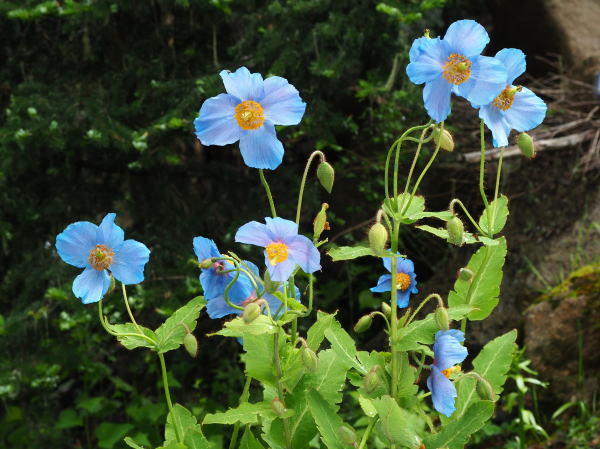 |
Meconopsis baileyi Mr. T takes a rest On the way to Seji La we took a toilet break and looked at under the bottom during pee. of the cliff, and glanced a blue flower. When we went down the steep slope, it is M. baileyi just blossomed. It was an unexpected harvest because we were not looking forward seeing this flower in mid July. M. Bailey was named after English Colonel F.M. Bailey who found the flower in 1913 in Ron Chu Valley near Yalung Tsangpo River. And later Kingdon Ward collected its seeds and brought a blue poppy boom to the UK. (Along National Road No. 318, alt. 4000m) |
|||||||||||||||||||||||||||
|
A sightseeing bus runs through the pass, but any passengers do not notice the blue poppy. (If they got interested in, blue poppies would have been taken up by their roots - Wow! ? ) 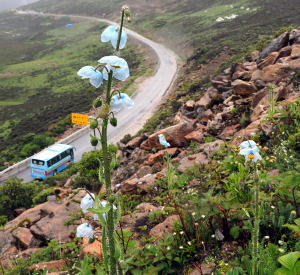 |
|||||||||||||||||||||||||||
|
|
|||||||||||||||||||||||||||
|
|
|||||||||||||||||||||||||||
| There are many various flowers in Seji La other than blue poppies. |
||||||||||||||||||||||||||||
|
|
|||||||||||||||||||||||||||
(2) Linzhe-Mi La Pass-Mozhugongka-Lhasa Running west on the Lin-Lha highway, which opened last year and connects Lhasa and Linzhi, it took only four hours while used to be taking a whole day. While there are road signs for “Bear Caution!”, but unlike northern island of Japan, Hokkaido, there are more cars than bears here. Getting off the highway on the way and ascending to Mi La shan. Used be (two year before) the Pass was crowded with cars and restaurants, but now there are less visitors and the restaurant is closed. Even no fee-collector existed at the pay toilet due to completion of a tunnel passing under. This pass may be abandoned in the future, but it may be good for flowers because the environmental destruction by human would be ceased. |
|||||||
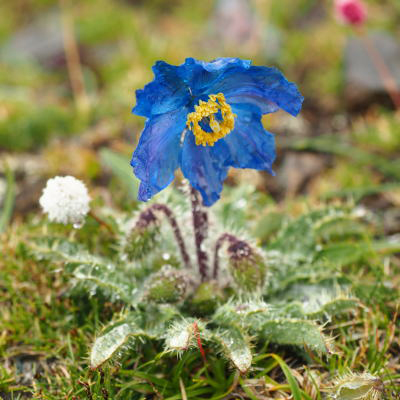 |
|
||||||
|
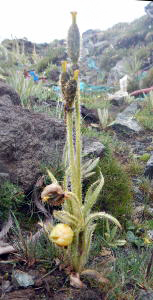 Fruit capsule Fruit capsule |
||||||
The sky clears up as we go down Mi La shan. Sunlight comes out. The blue sky extends over Lhasa city. This is a good sign for us. And barley and rapeseed field are waiting for harvest. This is a Tibetan feature of this period. |
|||||||
|
|||||||
| (3) Around Lhasa Based on the hotel in Lhasa City, we searched for flowers in the northern mountains, Linzhou County, and around Ganding Temple. The purpose was of course to find M. Torquata. Luckily on the first day of exploration we made it. The next day, it was snow in the mountain. If we were one day late, it was difficult to find the flower hidden in the snow and even to reach the place. |
|||||||
| Habitat of M. Torquata It roots into a little soil between large granite boulder containing iron. The surrounding area is a scree of boulders.The slope where the river flows becomes a pasture for yaks. Small flies gathering in the yak's dunk are pollinators. The withered stem on the right side of the flower is a flower from last year. Under it there are young leaves that will bloom next year. |
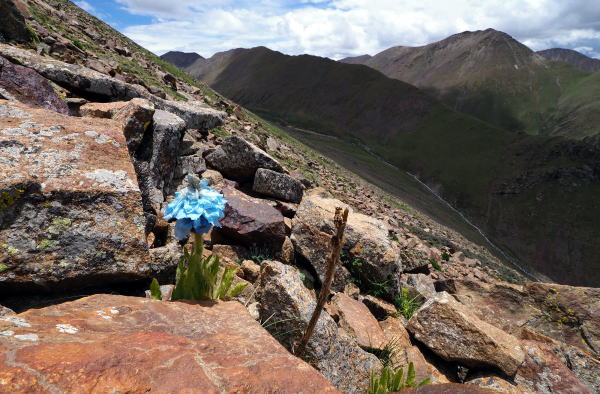 |
|||||||||||||
|
||||||||||||||
|
|
|||||||||||||
|
||||||||||||||
| (4) Sichuan Northwest | ||||||||||||||
| This is the second time since 2013 when I visited for the first time to look for blue poppies in China. Thanks to the western development, every city and town have been improved and become very beautiful. What surprised me most is that Chengdu-Kangding is connected in 4 hours, which once took a whole day, because of the completion of highway and Luding Bridge over the Dadouhe River. The technology to dig a long tunnel will not be inferior to Japan. However, as the Sichuan earthquake in May 2008 revealed that many buildings collapsed due to the hand-cutting work, it is impossible to say that you are 100% safe. | ||||||||||||||
|
||||||||||||||
Zhedoushan Pass (alt. 4300m) locates about 20km west from Kangding. This pass separates the Sichuan Basin and the Tibetan Plateau. Beyond here, the climate changes and becomes a dry climate and the blue sky spreads. Accordingly the vegetation changes and blue poppies begin to appear. The blue poppy used to be often seen on the southern slope where now becomes a major tourist destination. A tourist information center is built, and there are many cars waiting for parking. Due to tourists' walk-in and step-on blue poppies have also drastically decreased. We could not find good blue poppies and gave up to look for and went down the hill, but fortunately we found good blue ones on the west slope.
It suddenly starts to rain even when the blue sky is spreading and soon it clears up - this is the characteristics of the Eastern Tibetan Plateau. At the corner of the ranch, many Tibetans gathered and an outdoor wedding ceremony was held. After the ceremony, the newlyweds show off in a car decorated with flowers and parade to the reception hall. It's like America style in some years ago. After passing the golden monastery (Gompa) in Tagong and running for a while, we glanced a blue flower on the cliffside. Parking car on the road shoulder, hurrying back and climbing the cliff, there is.... |
||||||||||
| Meconopsis prattii | ||||||||||
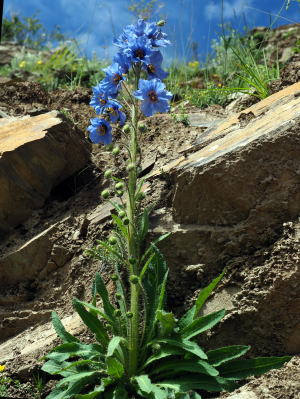 |
|
|||||||||
|
|||||
| Blue poppy searching is not our primary purpose during Sichuan trip - searching for a yellow iris, Iris narcissiflora. There are many yellow irises in the southern hemisphere such as genus Moraea in South Africa. But there are a few wild yellow irises in the northern hemisphere, such as Iris pseudacorus native to Europe and Iris danfordiae in Turkey. And the flower's outer and inner petals are open flatly. It was collected by a Swedish doctor in 1922, but the sample was incomplete and details were unknown. Later in 1992 English climber took a picture near Mt. Kong. Based on that, K. Ogisu, a Japanese plant researcher, found it in the west of Mt. Konga in 2002. Thanks to the report from a guide who found this flower by chance in another place last year we started to explore. |
|||||
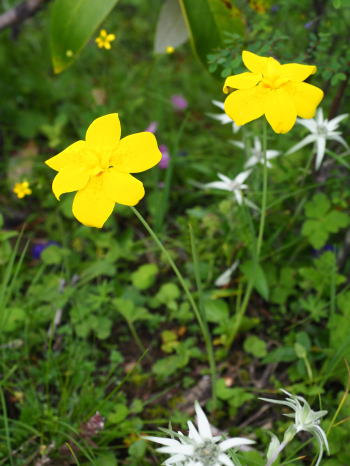 t. t. |
|
||||||||||
| During this season, various flowers bloom all at once as if they were competing for the benefits of the short summer sun. The field is full of a hundred flowers. | |||||||||||
|
|
||||||||||
|
|
||||||||||
|
|
||||||||||
|
|
||||||||||
|
|
||||||||||
| This looks like Chinese trumpet creeper (Campsis grandiflora) which blooms lots of hot orange flowers in summer. | |||||||||||
|
|||||||||||
To Top page of Insite Research
2019..8.21 uploaded